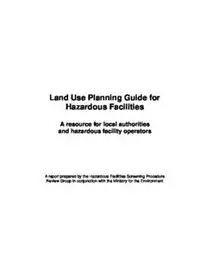
Land Use Planning Guide for Hazardous Facilities PDF
Preview Land Use Planning Guide for Hazardous Facilities
Land Use Planning Guide for Hazardous Facilities A resource for local authorities and hazardous facility operators A report prepared by the Hazardous Facilities Screening Procedure Review Group in conjunction with the Ministry for the Environment Published in February 2002 by the Ministry for the Environment PO Box 10-362, Wellington, New Zealand ISBN: 0-478-24053-8 ME number: 424 Acknowledgements The Ministry for the Environment would like to acknowledge the assistance and input of the following people in preparing the review of the Hazardous Facilities Screening Procedure: • Patricia Blütner, Auckland Regional Council • Susie Wood, Environment and Business Group Limited • Norbert Schaffoener, resources – Hazardous Substance and Resource Management Consulting • Kerry Laing, Tonkin and Taylor • Peter Dawson, ERMA NZ • Sue Scobie, ERMA NZ • Richard Harkness, Alandale Planning. Their assistance is greatly appreciated. The Ministry for the Environment would also like to thank and acknowledge the following people in the prepartion of the original Hazardous Facilities Screening Procedure: • Norbert Schaffoener, resources – Hazardous Substance and Resource Management Consulting • Patricia Blütner, Auckland Regional Council • Susie Wood, Environment and Business Group Limited. Many thanks also go to the peer reviewers of the original Hazardous Facilities Screening Procedure: • Rex Alexander, Dunedin City Council • Mike Avery, Stratford District Council • James Corbett, Manukau City Council • Jenny Easton, Tasman District Council • David Elms, University of Canterbury • Peter Dawson, ERMA New Zealand • Dick Fong, Waitakere City Council • Steve Markham, Tasman District Council • Alan Matheson, Meritec Ltd • Matthew Trlin, Palmerston North City Council. This guide is designed to complement the Assessment Guide for Hazardous Facilities (MfE, 1999c). Land Use Planning Guide for Hazardous Facilities iii For further information Resource Management Group ERMA New Zealand Ministry for the Environment PO Box 131 PO Box 10-362 Wellington Wellington Phone (04) 917 7400 Phone (04) 916 2426 www.mfe.govt.nz Email: Land Use Planning Guide for Hazardous Facilities v Contents Acknowledgements iii Quick Guide to Land Use Planning for Hazardous Facilities 1 Chapter Overview 17 1 Introduction 19 1.1 Purpose 19 1.2 What are hazardous facilities? 19 1.3 Land use planning for hazardous facilities 20 1.4 Revisions 21 2 Regulatory Framework 23 2.1 Resource Management Act 1991 (RMA) 23 2.2 Hazardous Substances and New Organisms Act 1996 (HSNO) 24 2.3 Links between HSNO and planning controls under the RMA 26 2.4 Other relevant legislation 26 3 Classification of Hazardous Substances 29 3.1 Background 29 3.2 The HSNO hazard classification system 29 4 Land Use Planning for Hazardous Substances under the RMA 33 4.1 Risks presented by hazardous substances 33 4.2 Objectives of land use planning methods and the HFSP 33 4.3 Planning methods 34 4.4 Minimum performance requirements for hazardous substances 36 4.5 Management systems 38 4.6 Preparation and assessment of resource consent applications for hazardous facilities under the RMA 39 5 The Hazardous Facility Screening Procedure (HFSP) 47 5.1 Background 47 5.2 Overview 49 5.3 Rating of hazardous substances for the HFSP 51 5.4 The step-by-step guide to the HFSP 52 5.5 Application of the HFSP 57 5.6 Exceptions and exemptions from the HFSP 59 vi Land Use Planning Guide for Hazardous Facilities 6 Linking the HFSP with the District Plan 63 6.1 The Consent Status Matrix 63 6.2 Consent Status Indices 63 6.3 How to develop a Consent Status Matrix 64 6.4 How to calibrate a Consent Status Matrix 66 6.5 Interfaces between incompatible land uses 69 7 Implementing and Administering the HFSP 71 7.1 Issues 71 7.2 Implementation and administration strategy 71 7.3 Monitoring the implementation process 75 8 Model District Plan Section on the HFSP 77 8.1 Background 77 8.2 Definitions 78 8.3 Other aspects of hazardous facilities management 79 Model HSFP for your District Plan 81 References 101 Bibliography: Background Documents and Databases on Hazardous Substances 103 List of Abbreviations 107 Glossary 109 Appendices Appendix A: HFSP Rating Criteria for Hazardous Substances 115 Appendix B: Hazardous Substances Hazard Ratings 121 Appendix C: Rating Guide 139 Appendix D: Spreadsheet for HFSP Calculations 151 Appendix E: Case Studies 153 Appendix F: Section 32 Explanation 167 Appendix G: Schedule to District Plan Section on Hazardous Facilities 193 Land Use Planning Guide for Hazardous Facilities vii List of Figures Figure 1: Overview of the HFSP process for a single substance 50 Figure 2: Overview of the step-by -step guide to the HFSP 52 Figure 3: Structure of the MfE hazardous facilities website 74 Figure F1: Overview of HFSP (process for single substance) 194 Figure F2: Step-by-step guide to the HFSP 196 List of Tables Quick Guide Table 1: Base quantities (B) for all effect types and hazard ratings 8 Quick Guide Table 2: Adjustment factors for all effect types 10 Table 1: Overview of changed HFSP terminology 49 Table 2: The HFSP step-by-step guide 53 Table 3: Base quantities (B) for all effect types and haz ard ratings 55 Table 4: Adjustment factors for all effect types 57 Table 5: Exceptions to the HFSP 59 Table 6: Example of a consent status matrix 64 Table 7: Example of a consent status matrix for a provincial service town 67 Table 8: Example of a consent status matrix for a small town 68 Table 9: Example of a consent status matrix for a metropolitan area with heavy industrial activity 68 Table F1: HFSP – Step-by-Step Guide 197 Table F2: Base quantities for all effect types and hazard levels 199 Table F3: Adjustment factors 201 viii Land Use Planning Guide for Hazardous Facilities Land Use Planning Guide for Hazardous Facilities ix
